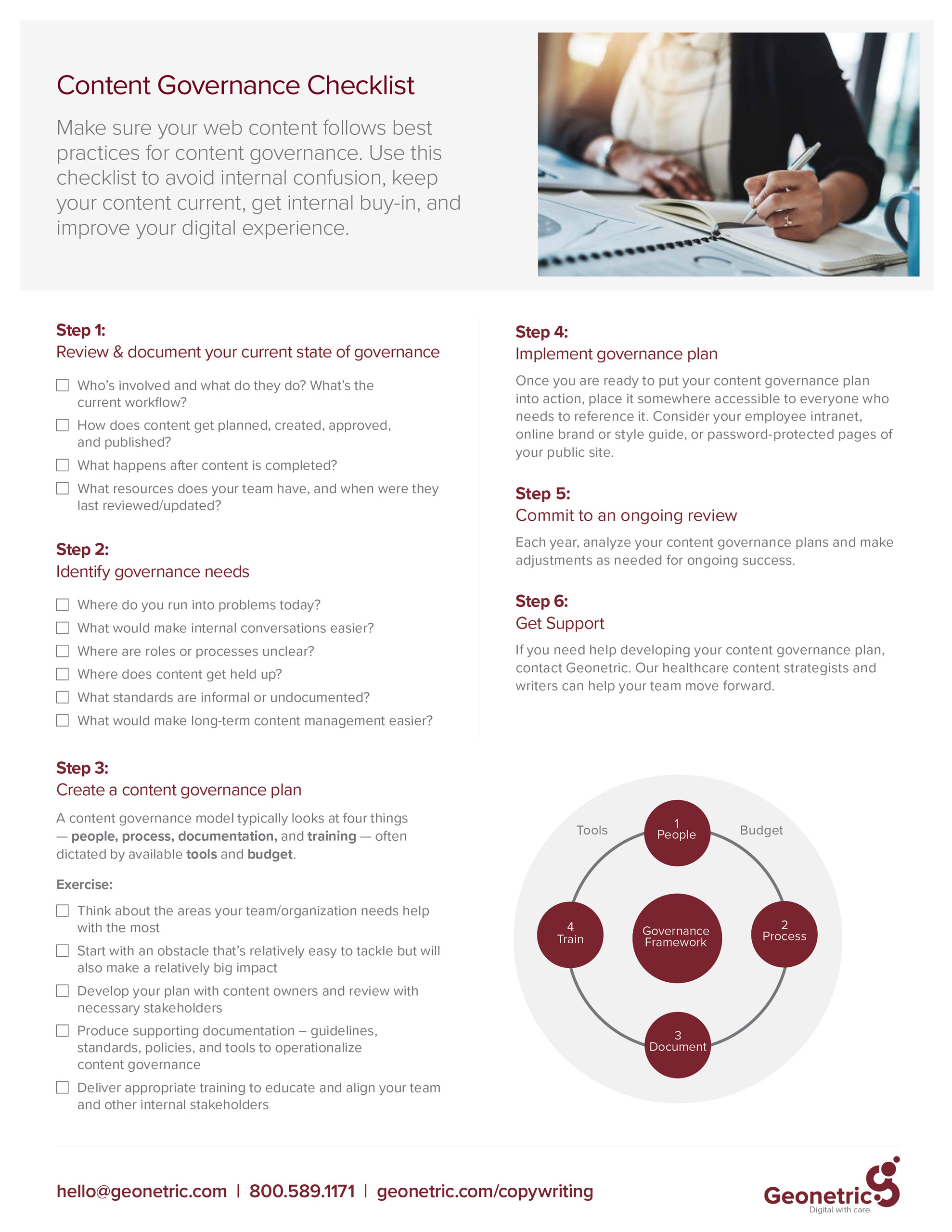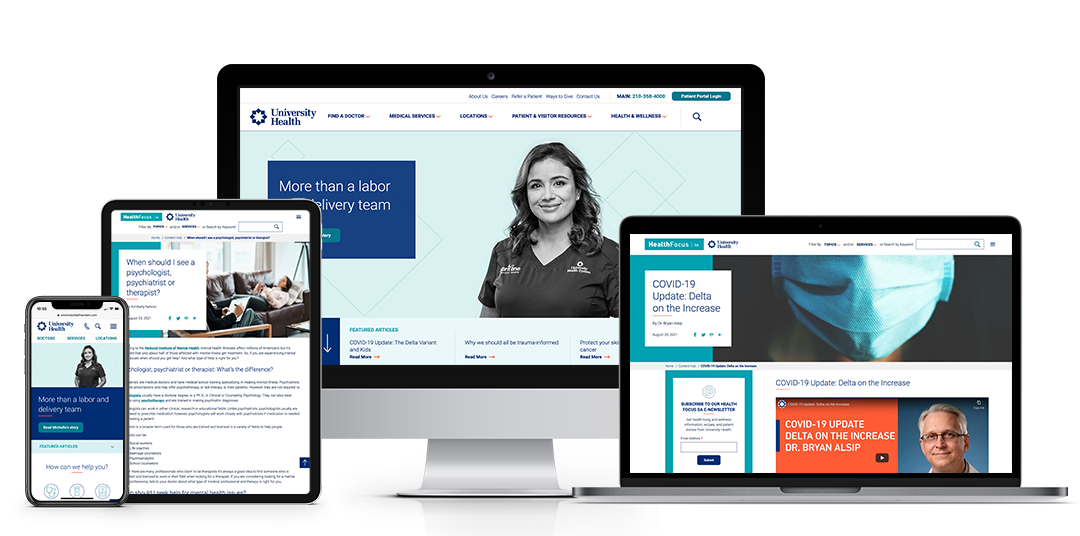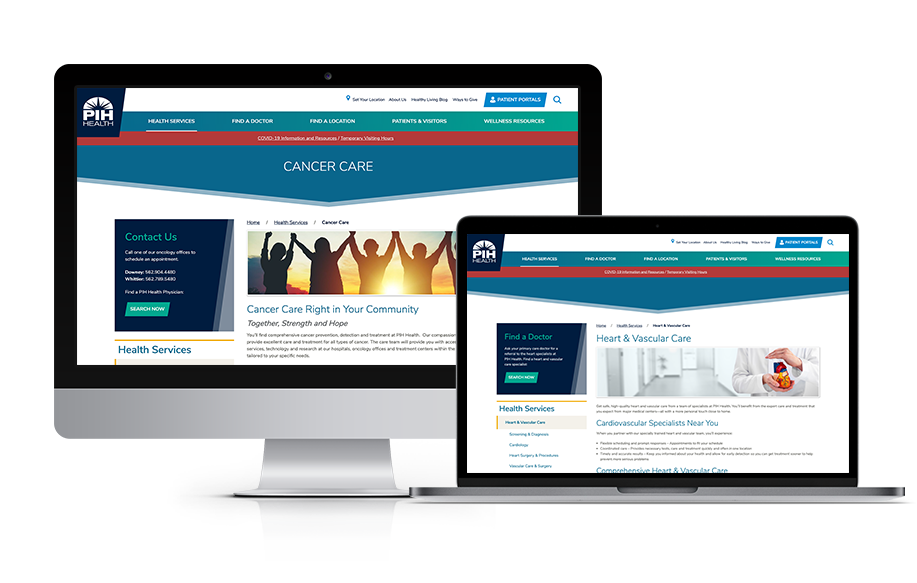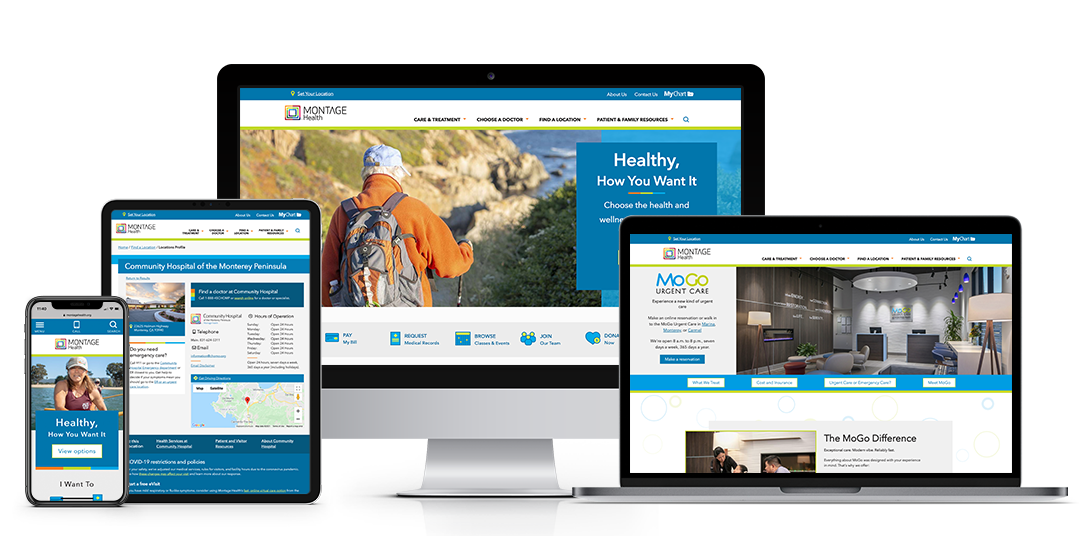It’s easy to see the benefits of a new site: a fresh look, new functionality, and a better UX. However, the key factors that lead to reimagining your site experience are not always as clear. Join us for a special redesign roundtable featuring experts in UX design, UX content strategy, search engine optimization and UX research as they discuss the signs that a website is no longer living up to its full user and business potential.
Content Type: Article

Redesign Roundtable: When Should Your Organization Consider a Full Site Redesign?

What Healthcare Marketers Need to Know about Google Analytics 4
Editor’s Note: This post was originally published in January 2021 when information on the timing of Google Analytics 4 (GA4) replacing Universal Analytics (UA) was limited. Google has since provided an expected transition date of July 1, 2023. After this date, UA properties will stop collecting new data. Beginning in January 2024, you may not be able to reference data from UA properties at all.
As a result, the move to GA4 should be a top priority for your team if you haven’t started. By making the change sooner rather than later, you ensure you have historical data available when you can no longer reference your existing UA properties. And in the words of the great philosopher Ferris Bueller: “Life moves pretty fast.” Similarly, exporting and saving needed historical data from UA should also be considered and prioritized. If you need help with this task or with safeguarding your data during the transition, please reach out for assistance. We don’t want anyone to lose access to information they’ve worked long and hard to create.
What is Google Analytics 4?
For eight years, the way you measure website traffic and behavior has remained largely unchanged. Google Analytics has been the broad standard, and while they’ve made changes and updates, the overall experience has been consistent since 2012.
Until now.
The version of the platform we all know and love was called Universal Analytics (UA) and was the third iteration of Google Analytics. Then, in October, Google rolled out a new update, GA4. Since then, the digital team at Geonetric has been testing the platform to understand how it affects healthcare websites and what impact it will have on your day-to-day data needs.
What has Google changed?
With this update, Google’s main goal was to make it easier to track users engaging with a website via both browser and app. However, there are changes to the platform—changes both beneficial and challenging—whether a website has a corresponding app or not.
Let’s look into the good and the bad – and what your next steps should be.
The good: Goodbye, bounce. Hello, engagement statistics.
Google is removing the concept of a bounce—a session that does not trigger a second action on the page—and bounce rate from its platform. Digital marketers often rely on that metric as a shorthand to measure user engagement with a given page, or even with a website as a whole, so it may seem like a loss. However, Google is using an Engaged Session and an Engagement Rate instead.
Engagement Rate is the percentage of Engaged Sessions vs. non-Engaged Sessions and the definition of an Engaged Session is any session that includes:
- The website or app in the foreground for at least 10 seconds
- A conversion event
- Two or more screen/page views
This change is particularly beneficial because you can now customize a conversion event to fit the on-page content and user experience. Whether or not there is a direct call to action present on the page, you now better understand how a page is performing.
Better understand your users with expanded event tracking
Additionally, Google is adding the number of data points available to digital marketers. When Geonetric launches a new website, we set up a robust amount of event tracking to ensure our clients have a more comprehensive picture of user behavior over a standard Google Analytics implementation. With the change to GA4, the amount of potential data points you can draw from our tracking has increased eightfold. This enhanced tracking requires set up to take advantage of, but is undoubtedly a great opportunity.
The bad: Missing features and historical data
Besides removing Bounce Rate and the additional set up necessary to take advantage of the new Event Tracking opportunities, there are a few additional challenges that come with GA4 as well.
First and foremost, it is still a new product, and there are a few areas—areas that we may currently rely on in UA—that are either not included or still in progress:
- Filtering capabilities
- View options
- Internal reporting options
Sunsetting of UA
Further, as the future of Google Analytics, GA4 will be the standard. There is no set date for this change, though it will happen just as Universal Analytics supplanted Google Analytics 2. Currently, new Universal Analytics/UA properties can be both created and accessed. In the future, this will likely change, although no one knows exactly when.
Loss of historical data
The most considerable challenge is that data will not be contiguous between UA and GA4. The two iterations are so distant that GA4 does not carry over historical data from its predecessor. When you upgrade, the historical data continues to live in a legacy Universal Analytics property, while a new GA4 property collects information moving forward. This update will make comparing data month-over-month or year-over-year challenging until you have used GA4 long enough to have its own historical data.
Your next steps with GA4
Given the impending loss of historical data, the work needed to migrate event tracking into GA4 format, and the uncertain future of Universal Analytics, we recommend setting up a GA4 property and running it alongside your existing UA properties.
Doing this allows you to build up historical data and get your team and stakeholders used to the new platform, data, look, and feel before a hard switch becomes necessary.
If you’re looking for help, reach out to set up some time with one of our digital marketing experts to discuss the benefits and implications specific to your digital presence. We can go over the next steps necessary and get you started on migrating to the GA4 platform.

Listen to Your Audience
According to a study from Google and Compete, Inc., most patients (61%) visit at least two health system websites before converting, and 88% of users are less likely to return to a website with a bad user experience.
Hopefully, the consumer’s online search leads to either a:
- Click through to your organization’s website—and a positive, reassuring website experience that makes it easy to find information and complete tasks
- Zero-click conversion when the user finds what they’re looking for or takes action on the search engine results page (SERP) without needing to click through to your site
Challenge & Opportunity
The best healthcare website experiences challenge the assumption healthcare must be complicated. They make it easy for users to find information in a way that matches their expectations. Consumers appreciate humanized, meaningful experiences that feel intuitive and reassuring.
That’s why it’s essential to put the user at the center of your strategy. The average healthcare consumer has little to no knowledge of the healthcare industry or your organization’s internal structure. And why should they? What’s important to them is getting the best care for themselves or a loved one. Depending on why they seek care, they may feel unwell and vulnerable. If you can simplify the journey to get care, so it feels almost effortless, you’ll earn gratitude and loyalty—and stand out from the competition.
Identify & Investigate
To understand consumer expectations and needs in your market, first, identify and prioritize the target audiences you want to reach through your digital marketing and communications efforts. Ask:
- What are their interests and preferences when getting care or interacting with healthcare organizations or providers online?
- What are their abilities when accessing, understanding, and making choices about health information?
- What are their assumptions or beliefs about your brand, services, locations, and providers?
- What tasks do they want to accomplish when they visit the website?
- Do they see themselves reflected or addressed in website navigation structures, content, and design?
- What message has resonated in the past? What didn’t perform as expected?
Do the Research
Combine data that are quantitative (numerical) and qualitative (nonnumerical, such as attitudes and experiences) to get the clearest possible picture. Plan to conduct research activities on an ongoing basis, setting benchmarks and comparing findings to understand market evolution.
There are various tactics to gather data. Here are a few examples of activities that could answer specific questions relevant to your strategy.
Purpose
Example Tactic(s)
Take the Next Step
Knowing your audience is essential to optimizing your website for users. Learn more by attending Geonetric’s upcoming webinar on applying a consumer-first lens to your healthcare brand architecture, downloading our new white paper, or contacting our team.

Applying a Consumer-first Lens to Your Healthcare Brand Architecture White Paper
Download this whitepaper on the importance of a consumer-first silo-systemization strategy and the common challenges it can help solve for hospitals and health systems of all sizes. You’ll learn tips for how to present your primary brand, sub-brands, and everything else your organization offers, including locations, services, and providers.
You’ll learn:
- Tactics to understand your target audiences so they can find your organization online and enjoy a positive experience during digital touchpoints
- Guidance to create your strategy—including when content silos are the right choice to represent your brand(s) online
- When you should tear silos down and apply your system strategy to promote your services and locations
Download our White Paper

Content Governance: How to Get Control of Your Healthcare Web Content
Your website is constantly evolving, and that’s why having a governance framework is essential. Healthcare organizations like yours seek guidance on how to establish internal accountability, define roles, and assign decision-making authority. Content governance can help avoid confusion, keep your content current, get internal buy-in, and improve your digital experience.
Signs you need help
It’s common to feel that your content is in a constant state of chaos, but you don’t have to. Your organization would benefit from content governance if you:
- Don’t have a consistent voice and tone throughout your website
- Don’t know what content exists on your website
- Struggle to maintain existing content
- Experience delays in getting content published because of inefficient content development, editing, and review processes
- Are unclear who approves the final content
- Have pages that haven’t had an update in years
- Have duplicate content
- Grapple with too many urgent, high-priority content requests
- Struggle to find content assets in your digital asset manager (DAM)
What is content governance?
Content governance is a plan to achieve your internal content strategy. It’s the framework that helps your team keep track of all the moving parts and determine how content gets created, reviewed, and published.
Benefits of governance
Maintaining good content on your website is vital to the user experience and your brand. It produces better results – for both end-users and your organization.
Internal benefits
Having a practical governance framework in place helps you:
- Align content with overall strategic direction, brand voice, and goals
- Increase productivity, accountability, and collaboration
- Resolve conflicts and questions more quickly because you can refer to agreed-upon procedures and direction
- Build a scalable and repeatable content operation process for current and future content contributors
- Protect your content from internal requests that don’t meet the priorities of your target audiences
- Reduce risk to reputation and legal status
- Enhance brand with consistent, high-quality experiences across digital properties
Audience benefits
Governance helps you create a better user experience. When you implement a solid content governance plan, your website visitors may find it easier to:
- Accomplish their top tasks
- Get to know your brand
- Know what to expect when they engage with your organization online
- Find relevant, up-to-date information
Governance framework
The main components of content governance include people, process, documentation, and training. Let’s look at each more closely.
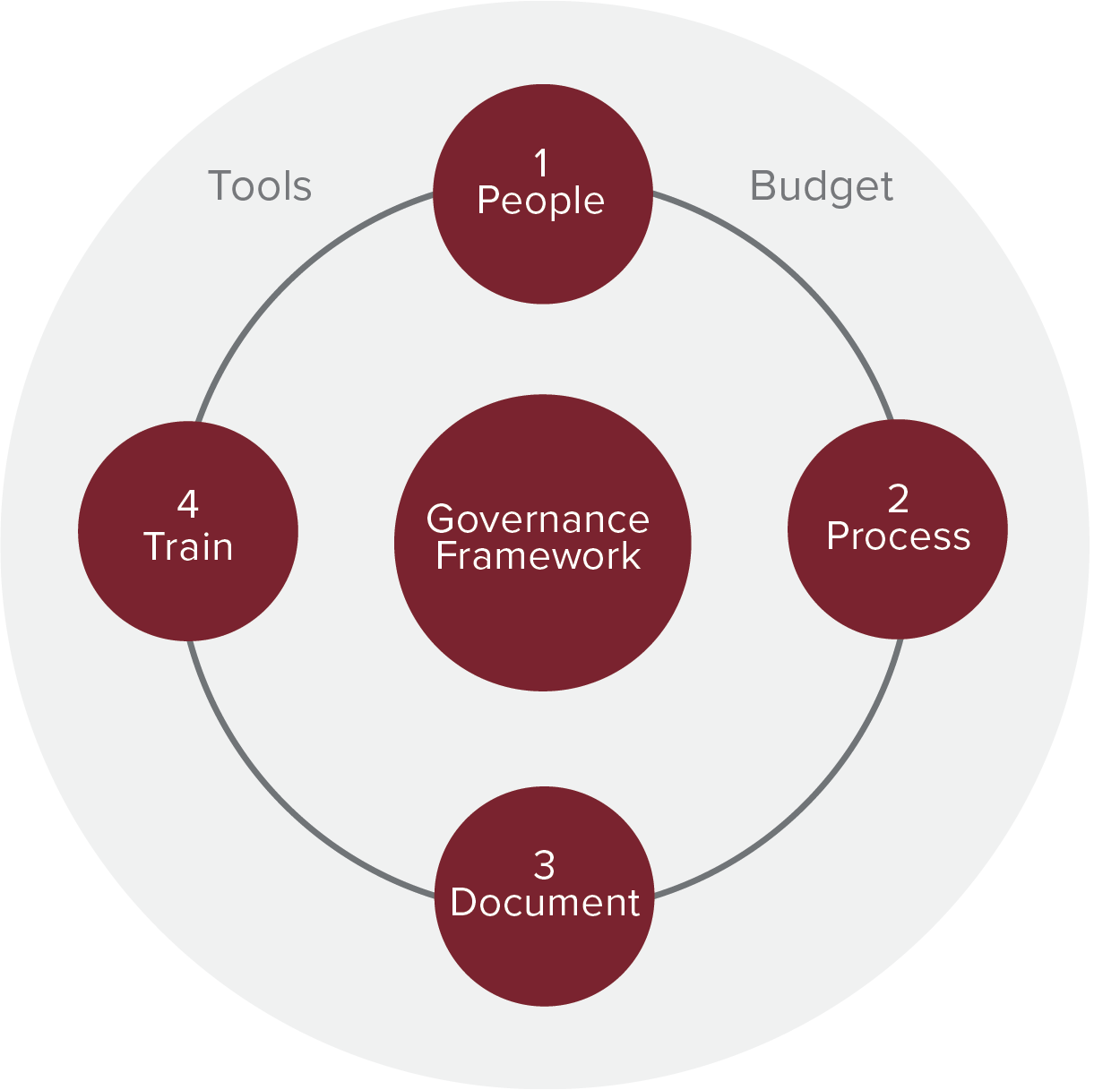
People
The first element of the framework is the people. It:
- Defines “who” and “what”
- Establishes roles, responsibilities, and decision-making authority
- Considers your core team, content contributors, and stakeholders
Process
Processes will get your team on the path to creating high-quality content with fewer delays, misunderstandings, and frustrations. Process:
- Defines “when,” “where,” and “how” to get content moving through your organization efficiently
- Establishes workflows related to planning, creating, publishing, and maintaining content
Documentation
Documents can pave the road for consistency and quality at your organization. Documentation:
- Defines “why” and “how”
- Establishes standards, policies, guidelines, and tools to encourage consistent, quality content
- Serves as a “single source of truth” to resolve confusion or conflicts
Content documentation examples include:
- Core content strategy statement
- Editorial style guide
- Content review checklist
- Editorial Calendar
- Stakeholder request decision tree
Training
Training makes sure everyone has the information they need to put your governance plan into action. This piece of governance can include different types and levels of training depending on roles and responsibilities.
Training examples:
- CMS/DAM training
- Writing for the web training
- Accessibility training
- Training on new or updated standards, policies, and guidelines
Where to start
In an ideal world, content governance starts early – before you begin writing content, designing layouts, uploading media, and publishing pages. However, your organization can benefit from moving forward with improving your governance anytime. Governance may fit seamlessly in your project timeline if you:
- Are ready for a redesign
- Hire a new team member
- Have changes in your organization or brand
- Have new content needs
- Hear concerns or complaints from stakeholders
- Implement new technology or features
Content governance tips
How to get started
As your website evolves, your governance plan should too. The key to getting started on developing or maturing your governance plan is to start by understanding where your team or organization is at today.
Contact us before you create your governance plan. Geonetric’s experts can facilitate discussions, share examples of approaches that have worked for other healthcare organizations, and help teams move governance documentation forward while still accomplishing day-to-day work.

Balancing Local Care and System Strengths: Finding Success with a Unified UX
Most health systems have shifted to a UX strategy focused on a single, unified site. But for many, the ongoing challenges of balancing competing interests and responding to organizational changes threaten to derail the user experience.
How do you represent a complex organization on the web in a way that creates good user experiences and supports business goals? That’s no easy task and there’s no set playbook to follow. But there is a common path to arriving at your right answer: Your target audiences. When you put their expectations, preferences, and needs at the center of your strategy, you’ll create an effective, meaningful user experience that drives your organization forward.
Join a team user experience, content strategy and search engine optimization experts from Geonetric and learn the steps you can take to determine the best way to present your brand—and everything that lives within it—online.

How Topic Clusters Improve SEO & UX
Topic clusters provide an excellent opportunity to empower your healthcare search engine optimization (SEO) efforts with targeted, local keywords and content that feel personable and customized. Plus, you don’t always have to redesign your entire site to take advantage.
Your prospective patients will feel like they’re experiencing a personalized journey rather than a narrow corridor leading them to a conversion point or an aimless path toward a possible destination. Even if the main goal is still to bring the user to your conversion point, making it a smoother process will leave a fantastic impression, increasing the chance they’ll commit once they reach that point.
However, do not mistake this relatively new strategy as an SEO vanity project. Search engine algorithms now favor robust topic structures above other forms of content.
What are topic clusters?
In many ways, topic clusters are an extension of building a content matrix tailored to a modern user experience. Topic clusters gather individual pieces of a complex subject and provide an organized, digestible content structure for humans and machines alike. This process starts with identifying pillar pages—pages that provide an overview of a specific topic covered on your website. Each pillar page then connects with subpages that expand upon that topic.
The end goal of topic clustering is to collect all content surrounding subjects into one interconnected section on the site. This has unique benefits for healthcare systems, as well.
What are the benefits of topic clusters?
While the main goal focuses on backend site structure, topic clustering also provides users with a clear path toward the content they’re seeking, without fear of becoming lost in the wrong section. By creating an internal linking strategy that only connects internal topics and their pillar, someone learning about your oncology services won’t stumble into pediatric primary care without intent.
Implementing a topic cluster strategy provides:
- A streamlined user experience
- A navigation structure that’s easier for bots and users to understand
- Improved content visibility, improving user comprehension without overwhelming them
- Increased content depth, allowing for high-level information as well as in-depth explanations of complex services, procedures and more without cluttering single pages
As with all digital endeavors, it’s important to remember that the user is most important. If the overall user experience has not been considered, it’s possible that their journey through your site takes them through multiple sections, microsites and forms before they arrive at what they’re looking for. This can disenfranchise the user and reduce the chances of them becoming a patient.
Looking to the future, starting the process of a site restructure in 2022 also puts you ahead of the competition as agencies and internal marketing teams adapt to a new methodology.
When considering these advantages, we must first understand why search engine optimization prefer topic clustering.
Understanding intention-focused search algorithms
A new era of search algorithms continues to evolve, starting with Google’s rollout of Hummingbird in 2013, RankBrain in 2015, BERT in 2019, and MUM’s announcement in 2021. These algorithm updates rely heavily on artificial intelligence and machine learning to bridge the gap between a searcher’s intent and search results.
Modern algorithms seek to determine which sites and pages provide the best value for resources or services through context and intent within pages and across site sections.
By connecting content around pillar pages, your site makes a stronger intent-based argument. When Google, Bing, and other search engines send their robots through your site, they understand the metadata, on-page content, structured data, and site layout better than ever without the need for handholding. A site will risk penalties and lose valuable conversions if its structure resembles a bowl of spaghetti.
How do you create a topic cluster?
The steps to creating topic clusters are relatively straightforward.
- Understand the current content and structure of your site
- Identify your pillar content (the broadest topics)
- Pinpoint content that belongs attached to each pillar (subtopics of the pillars)
- Map subtopics to the pillar pages
In healthcare, your journey into clustering could start within a content audit of a service line. Let’s take breast cancer as a pillar page. You then outline subtopics that fall within its reach. Some subtopics might include:
- Prevention & Detection
- Mammograms
- Screenings
- Breast Cancer Diagnosis
- Breast Cancer Care/Treatment
- The Breast Care Team
- Coping with Side Effects
- Survivorship Care
- Clinical Trials
With this list created, build your new navigation and linking structure to have each item stem from the main Breast Cancer page. From this, map how to link between the cancer types to create sturdy connections between each subsection and subpage, forming a clearer intent for search algorithms.
The goal is to have dense clusters surrounding each pillar with calculated connections to other pillars. This method is built for search engines and users, but also becomes beneficial to identifying any missing subtopics that you might create in the future for each pillar, thus increasing topic depth even more. As you begin to think about all of the different pillars your site might have, the possibilities become endless and possibly overwhelming.
Long-term benefits
Topic clusters provide an opportunity to visualize your current content governance strategy in a new way, as well. Creating a navigation system utilizing this method reduces the possibility of internal debate over where particular pages reside within a framework since it is built for adding new content with ease.
Ask these questions when adding new content to your site:
- Is this broad enough to be a pillar topic?
- Which pages are most important for internal crosslinking?
- Should this be a single page or spread out for deeper exploration of the subject matter?
- How would the subject fit into our overall site navigation?
By asking these types of questions, you remain focused on creating a lasting structure that pleases prospects and increases conversions.
Kickstart your topic clustering strategy with Geonetric
Check out how we used topic clustering for PIH Health on their new award-winning cancer care content that follows the patient journey through prevention, diagnosis, treatment and follow-up care – and then contact us to see how we can help you use topic clustering to improve your user experience.

The Healthcare Loyalty Crisis
The problem is, there is a loyalty crisis in healthcare. It’s never been as strong as many organizations would have liked – and loyalty has only declined through the pandemic.
According to Klein and Partners’ 2020 Wave IV Omnibus Study (December 2020), only 18% of consumers are unwilling to consider switching providers. This is down from 41% of consumers in Wave II of the study (May 2020). That’s a 56% decrease in loyalty in just the last six months of 2020.
This is a continuation of what we’ve been seeing over the last few years, with the pandemic accelerating the erosion of loyalty.
What’s causing the shift in loyalty?
For years, broader macro-trends have been impacting the healthcare space. There are more players than ever before, from concierge medical practices to Walmart’s rapidly expanding Care Clinics to new telehealth offerings through employers or insurers.
But the emergence of new players and increased choice isn’t the only issue. Health systems also have had a hand in loyalty erosion. Primary care has become more transactional than ever before. In most markets, it’s tough to see your primary care provider (PCP) on short notice. Health systems have been steering their patients increasingly to urgent care instead of their PCP or to a mid-tier provider instead of the PCP. Sometimes, patients are just going to a same-day care option because they can’t get in to see their PCP.
The trouble is that the patient relationship has always been with the PCP. We’ve broken that relationship to a large extent and haven’t been particularly effective in replacing it with a new relationship with the health system.
Pandemic accelerated shifting access options
Over the last 18 months, there were numerous times different services opened and closed, which led to cancellations and rescheduling that was often a suboptimal experience.
Many consumers tried other care delivery alternatives out of necessity, whether at a traditional competitor or a high-convenience alternative like Walgreens or CVS. These other options also became key players for getting vaccines and testing into the community. Consumers tried these options, and for many their experiences were good.
Competition in healthcare is fierce
With such tough, growing competition, how do you compete?
- Quality: There are some situations where healthcare systems can compete on quality or the availability of specific services, but overall, most services are available from multiple competitors, all with an assumed level of clinical competency.
- Communication: Electronic health record (EHR) vendors’ patient portals aren’t going to get you there, either, with many health systems in any given market often running the same EHR, some of which make it easier for consumers to share their records between provider organizations.
- Price: There are a few situations where we can compete on price. Most services are negotiated with insurers or, in some cases, are regulated by the state. Consumer-paid services provide some opportunities here, but they seem to be utilized primarily for low-dollar options such as urgent care.
- Convenience: Easy access to care and consumer experience are the places with the best opportunities for increasing competitiveness. When you can make obtaining services easier and faster, your brand can gain preference.
Addressing the convenience and the consumer experience
There are several strategies for addressing consumer experience.
To date, improving convenience and consumer experience has focused on putting offices closer to consumers, offering better parking, training staff to make the experience better, offering extended hours and improving the availability of appointments.
But what’s next? The new frontier for this experience will take place digitally. What many are referring to as the digital front door:
- Better information and education
- Easy tools to find care options
- Simple and intuitive scheduling experiences
- Easy online care delivery through telehealth
Learn more about the digital trends driving healthcare in the coming year. Check out our recent webinar on Top Trends in Reimaging the Healthcare Digital Experience. We cover how healthcare organizations use digital to create new competitive differentiation and drive loyalty. Also, check out our latest eBook on building a digital front door and beyond for more tips on supporting consumers in a personal, seamless way that enables self-service.

3 Examples of Award-Winning Healthcare Web Content
Effective healthcare content explains the complexities of a healthcare system, generates traffic, and makes conversions. Web copy can be difficult to structure and develop. But when done correctly, your website benefits from being user-focused, optimized for search and easy for site visitors to take the next step.
What does it take to be award-winning?
Writing effective web content is as much art as science, and our popular guide on Web Writing for Healthcare takes an excellent in-depth look at what it takes to create content your users want. At a high-level, great content:
- Adheres to best practices for readability and accessibility
- Cross-links strategically
- Focuses on the user, particularly your unique personas
- Follows search engine optimization best practices
- Follows the patient journey
- Leverages the right call to action
- Uses the right voice, tone and style
Check out these recent award-winning medical websites that put those best practices to work and received recognition for developing and delivering engaging content.
2021 award-winning healthcare web content
The 2021 content healthcare award winners have all invested in comprehensive web content strategies and development to strengthen their brand and top their competition. Read on for more details.
University Health
As an academic medical center, University Health, in San Antonio and Bexar County, Texas, used personas to guide personalization and content marketing efforts, earning them a Platinum MarCom award for Web Content.
With the redesign goal of making their website more system-centric and easier for site visitors to find the information they need quickly, University Health used:
- Crosslinking strategies to connect services, providers, and locations sitewide
- Strategic drop-down menus in the main navigation
- Sophisticated taxonomy to help users get helpful site search results
- Links in its expanded footer to address secondary audience needs
The new content used personas, created from consumer research and web analytics, to write compelling content for service lines, campaigns and content marketing hub articles. These comprehensive, patient-first pages showcase University Health as an understanding, expert academic health system. This approach aligns with the organizational goal to enhance its brand in the community and highlight its alignment with UT Health San Antonio.
To keep the content user-focus, University Health worked with Geonetric to:
- Create content for University Children’s Health pediatric transplant program and pediatric cancer services
- Develop 78 pages of content for four service lines
- Restructure and write new content to bring the Transplant microsite into the new University Health website
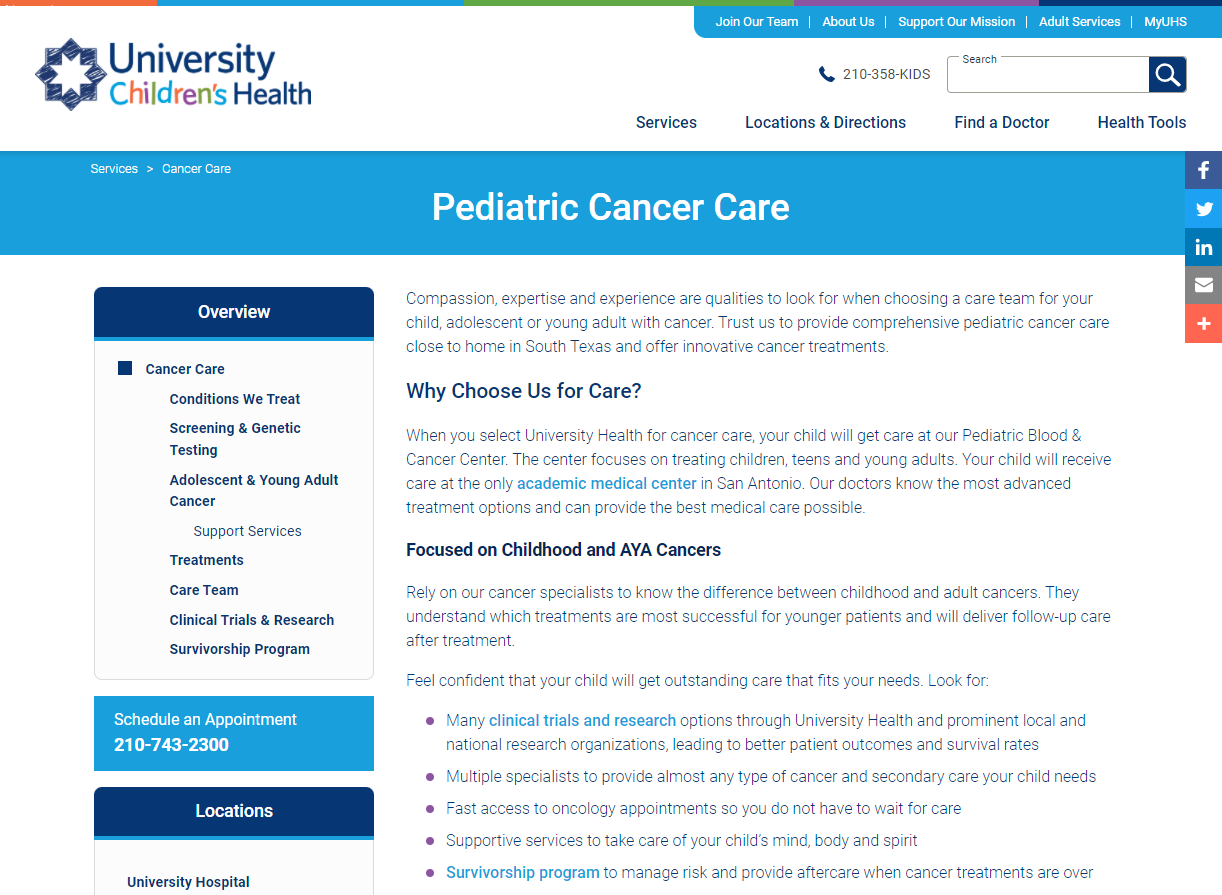
PIH Health
PIH Health’s new website uses web copy to differentiate their growing health system from their competition across Southern California, earning recognition as a finalist for Ragan’s PR Daily Awards, Patient-Focused Content.
Watch this video (8:33) on how PIH Health makes their content accessible.
PIH Health’s investment in content integrates content from two websites for new, search-optimized cancer and heart web copy that follows the patient journey, web writing best practices and PIH Health’s brand guidelines.
Each section has pages on prevention, diagnosis, treatment and follow-up care. This approach follows the patient journey so users can find information relevant to them.
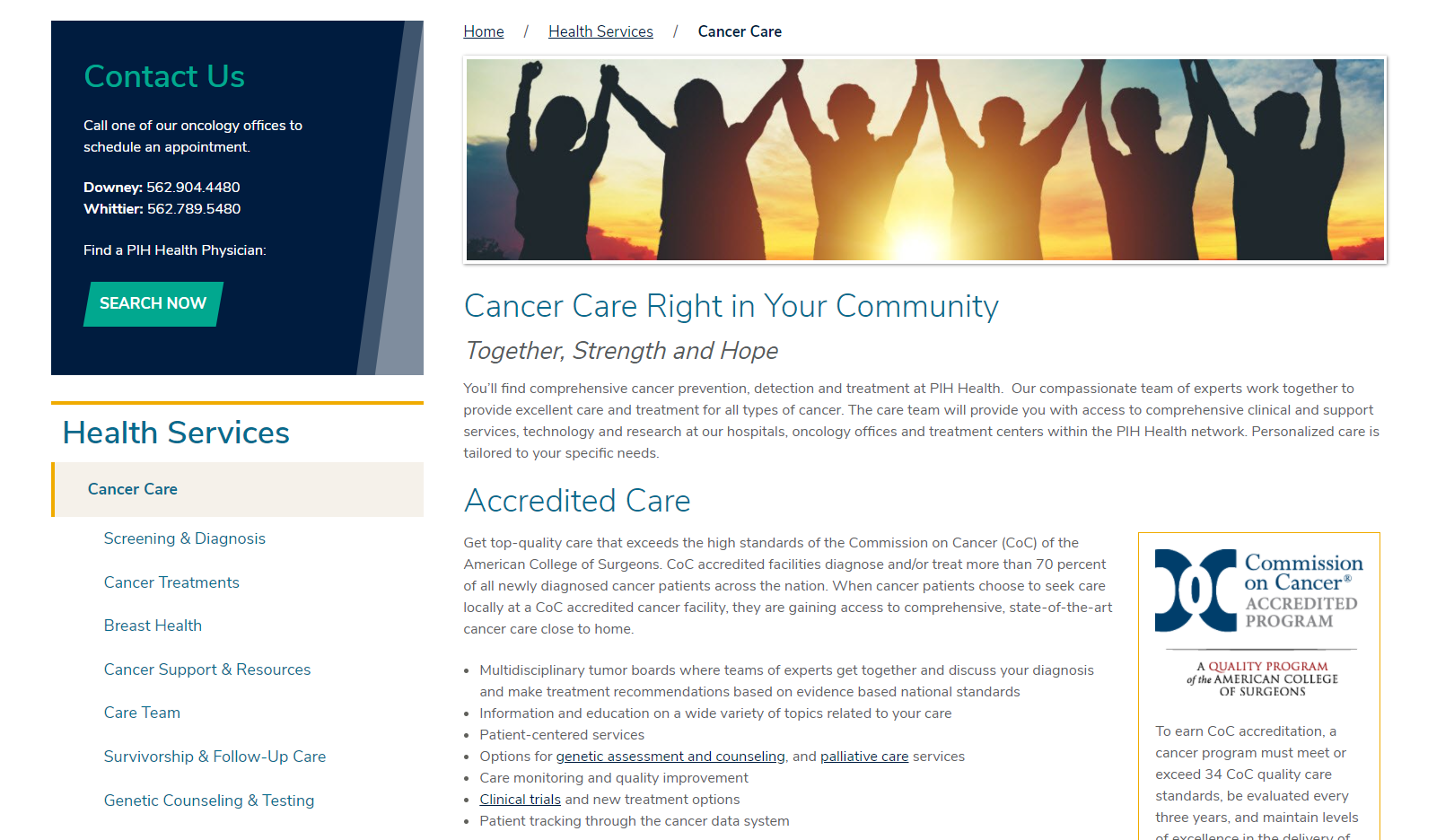
The new content highlights the many reasons patients benefit when they choose PIH Health for care and makes it intuitive for users to take the next step with prominent, easy-to-understand calls to action.
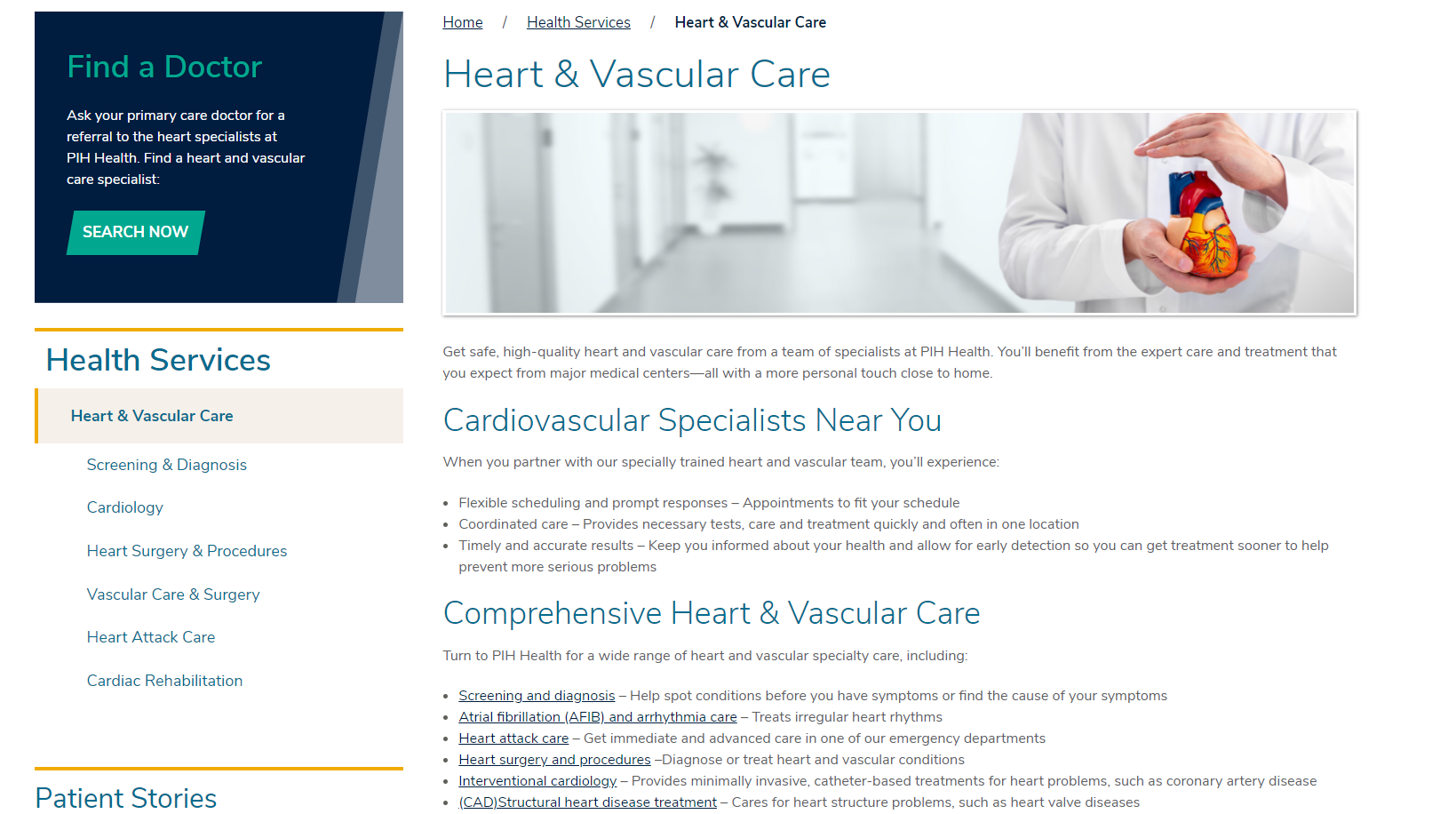
Montage Health
Montage Health, in Monterey, California, developed user-centric copy for its new website, earning them an Honorable Mention MarCom award for Web Writing.
To boost traffic and engagement, Montage Health’s content:
- Adheres to proven web writing best practices
- Answers users’ top questions
- Follows the patient journey
- Uses cross-linking strategy
Montage Health has 420 pages of new content throughout their new site, including:
- 48 service line sections (217 pages total)
- 55 location profiles
- About us section
- Accessibility statement
- For healthcare and professionals section
- Montage Health Foundation section
- Patient and family resources section
In addition to new content, Montage Health took advantage of content governance training and recommendations related to their video and classes and events calendar categorization strategies.
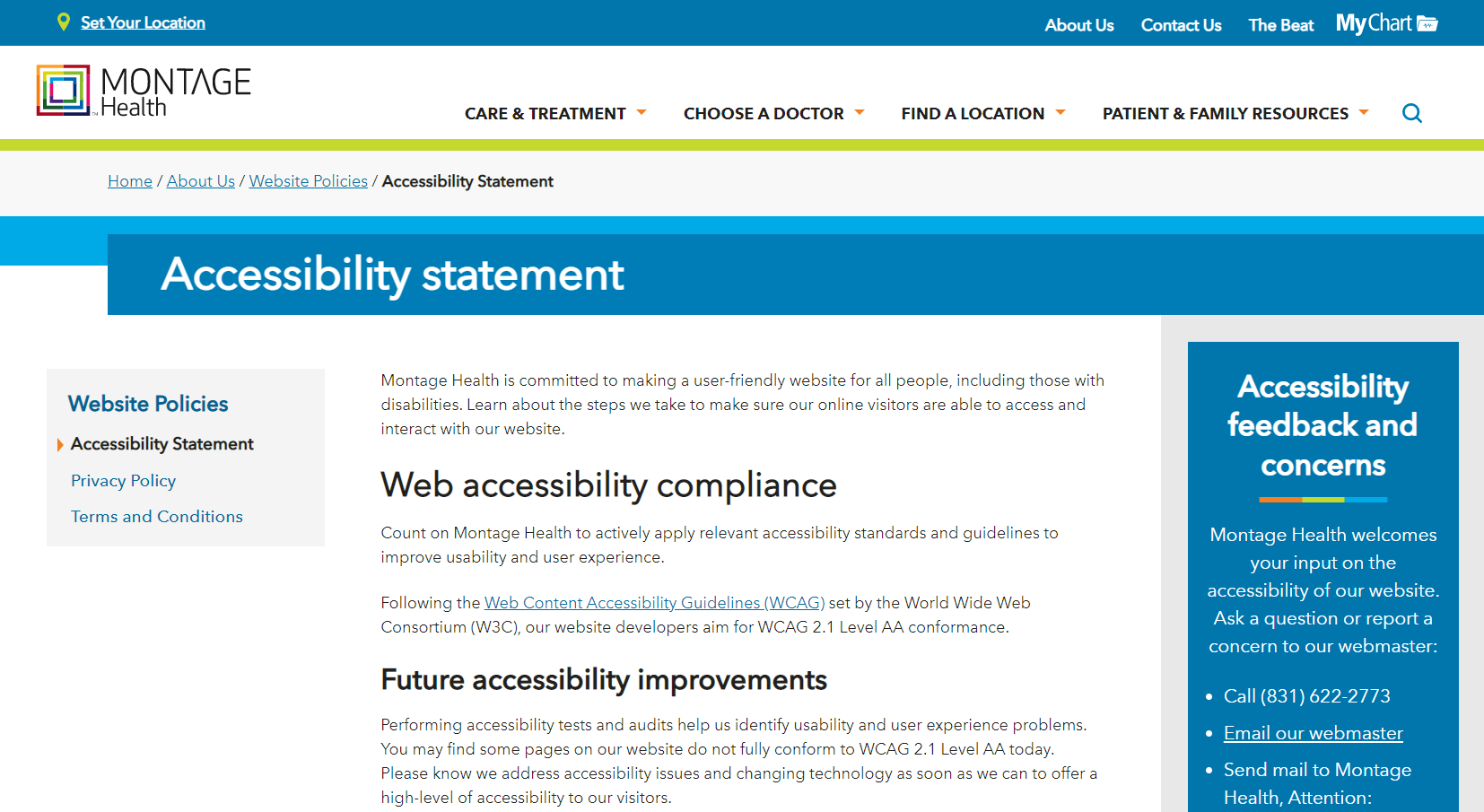
Put the user first, and the accolades will follow
None of these healthcare organizations set out to win healthcare content awards. They approached their web content with the users in mind – enlisting user research, building on personas and following key web writing best practices to tell their story and differentiate themselves from the competition. They also all enlisted the help of an outside content expert – their digital experience agency Geonetric.
Whether you’re re-examining your web content as part of a redesign or as part of an iterative approach to improving your site, depending on the expertise of healthcare copywriters can make the process more effective. Contact us today for a free consult, to sign up for a writing workshop or to outsource your healthcare writing project to our copywriting professionals.

Why User Experience Research is Key to Optimizing Healthcare Websites
Advantages of UX research
UX research serves many purposes throughout the design process. It helps identify and prove or disprove assumptions, find commonalities across target audience members, and recognize their needs, goals and mental models.
When you bring your consumer data into the conversation through implementing UX research early and often, your health system will:
- Save money by getting your design strategy right the first time
- Build brand loyalty by giving web users what they want
- Save time by optimizing solutions before launch
- Increase conversions by helping consumers find what they need
- Improve your search engine optimization (SEO) through user-engagement metrics like time spent on page
Types of research methods
As healthcare marketers, we rely on Google Analytics (GA) to help determine if our website is effective for our users. However, GA doesn’t always explain how to fix the problems to make it more user-friendly. That’s where UX research comes in, to help drive optimized solutions. User research methods include:
- Quantitative data, which are numerical measurements and observations
- Qualitative data, which are subjective motivations and desires (the “why”)
Why UX research works
Quantitative and qualitative data informs you of your web visitors’ behavior online and what they think about their digital experience. UX research brings valuable insight during each phase of UX strategy and UX design, such as:
- Planning – Drives strategy and design with up-front research that helps you understand your users
- Building – Tests strategy and design to give you direction on what’s working well and what to iterate
- Launching – Brings validation to your strategy and design to help you maximize your efforts
- Ongoing – Continues to test solutions in real-time, post-launch to keep your site optimized for consumers
Eliminate expense & save time
It costs your organization money when you don’t get things correct the first time, especially when you don’t meet the demands and expectations of your website visitors. This is called UX debt and can happen when you skip user testing, design by committee, or disregard brand and style guides. According to experts in research-based UX, the Nielson Norman Group, UX debt can pile up over time and, if left unaddressed, leads to compounding user problems and costly cleanup.
UX debt you can avoid
It costs your organization money and time if you have to:
- Redesign and recode
- Fix elements to meet accessibility requirements
- Rewrite content for clarity
- Rework your information architecture
- Recreate the customer journey
When done correctly, UX research can save you money and eliminate future expenses by getting your website to hit the mark for your target audience and organization before launch.
Build brand loyalty with a competitive advantage
It’s no surprise that since the pandemic, consumers have been more digitally focused. Even people who weren’t tech-savvy before became tech-savvy through frequent online transactions like online shopping and grocery order pickups. Because of this, your website consumers have new, higher expectations of an easy-to-use, intuitive digital experience.
To gain a competitive advantage and give people a site they love, you need to create an experience that gets at the heart and minds of your consumers.
The path to putting you ahead is UX research because it will tell you:
- What consumers think about your brand or a competitor’s brand
- Past experiences that lend insight into the patient journey and decision-making, both online and offline
- Consumers’ first impressions of your website’s design (imagery, colors, layout) and how it reflects on your brand
- How consumers currently find care online, and how consumers prefer to find care online
- Which parts of the user journey are the most difficult or confusing to consumers
- Barriers to the user journey along the most critical conversion paths
- How the website does or doesn’t meet the user’s expectations
- Where to invest your dollars based on real consumer feedback
At its core, UX research helps you uncover problems early and capitalize on them as design opportunities.
Improve SEO
UX research drives a robust UX relevant to your users and provides them with a positive digital experience. These custom experiences won’t go unnoticed by search engines.
SEO now factors in the user-friendliness of your website when ranking searches for users. User-friendliness through the lens of SEO looks at factors such as:
- Mobile-friendliness
- Core Web Vitals (loading, interactivity, and visual stability)
- Safe browsing
- No intrusive interstitials or pop-ups
- Page load speed
- UX metrics (dwell time, bounce rate)
When more people can find your healthcare system’s website in organic (non-paid) search results, you’ll increase overall site engagement and continue to make a favorable impact on your users.
Drive conversions and revenue
Once search engines and your consumers see you as a trusted source of information and your website provides a good UX that helps meet their needs and solves their problems, you’ll see an increase in online conversions.
Your website will leave an impression after each initial visit. That’s because consumers are looking to connect with a website that’s easy to use. Once they find one, they’re likely to return even if they don’t convert the first time.
What’s more, if you’re dedicated to iterative optimizations even after site launch, you’ll see a continuous improvement that will help you drive revenue and impact your bottom line.
Hit the mark the first time
Ready to dive into the behavior and minds of your consumers? Contact us – we can tell you how your users behave and how they feel about your services with real-time UX research. You’ll get the chance to be involved in the whole process and benefit from working with a partner who knows what to look for, pitfalls to avoid, and how to translate the results into an optimized digital experience.
